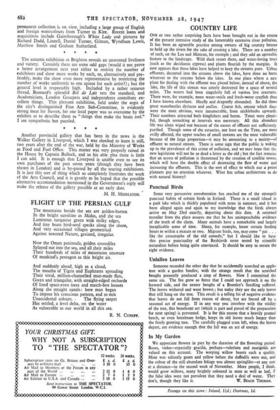ART
JoHN TUNNARD'S new exhibition at the Lefevre Gallery shows him moving—as Piper and other painters of romantic temperament have moved before him—steadily, if slowly, away from the intellectual fireworks of pure abstraction towards a more representational art. Fish, trees, a plough, figures and heads make their appearance. Curiously, I found these more explicit statements less lucid than the-implications of his earlier work. Although of greater complexity, or at least containing a greater number of elements, they are clouded, many of them, by a fudgy amorphousness and a certain irresolution of colour. With the jettisoned precision and finesse of technique seems to have gone the clear, self-sufficient logic of the earlier pic- tures. I suspect this is a transitional phase, encumbered by all the difficulties of moving house. All credit to a painter who seeks to avoid the mass-production of past successes ad nauseam.
* *
At Batsford's may be seen drawings by Ronald Searle. Searle has been forced by the fortunes of war to concentrate on graphic expression as an end in itself, and it would be hard to judge whether this exhibition shows his powers fully extended or hints at reserves as yet untapped. The nervous sensibility of his line is direct, precise and clever. Perhaps a shade too clever, for mannerism sometimes lurks around the corner. On the other hand, the few gouaches suggest a broadening and deepening technique of considerable promise. My guess is that his talent is likely to develop greatly and his progress prove more than interesting.
* * An important exhibition of work by Van Gogh will open at the Tate in about a fortnight. In the meantime, a selection from the
permanent collection is on view, including a large group of English and foreign watercolours from Turner to Klee. Recent loans and acquisitions include Gainsborough's White Lady and pictures by Richard Dadd, Linnell, Daniel Turner, Gilman, Wyndham Lewis, Matthew Smith and Graham Sutherland.
The autumn exhibition at Brighton reveals an unwonted liveliness and variety. Certainly there are some odd gaps (would it not prove a better arrangement next year either to restrict the number of exhibitors and show more works by each, or, alternatively and pre- ferably, make the show even more representative by restricting the number of works uniformly to one apiece for each artist?) ; but the general level is respectably high. Included by a rather tenuous thread, Bonnard's splendid Bol de Lait sets the standard, and Academicians, London Groupers and independents contribute ex- cellent things. This pleasant exhibition, held under the aegis of the city's distinguished Fine Arts Sub_Committee, is evidently strong meat for Sussex, for one local paper was so overcome by the exhibits as to describe them as " things that make the brain reel."
I am sympathetic but puzzled.
* * * *
Another provincial gallery that has been in the news is the Walker Gallery in Liverpool, which I was shocked to learn is still, two years after the end of the war, held by the Ministry of Works as Food and Fuel Office. This mattes was very properly raised in the House by Captain Bullock, and to his able plea there is little I can add. It is enough that Liverpool is unable even to see its own purchases of the past seven years (though they have been shown in London) and is by-passed by all the touring exhibitions. It is just this sort of thing which so completely frustrates the work of the Arts Council, and it is greatly to be hoped that the possible alternative accommodation mentioned in the Government's reply will make the release of the gallery possible at an early date.
M. H. MIDDLETON.





























 Previous page
Previous page